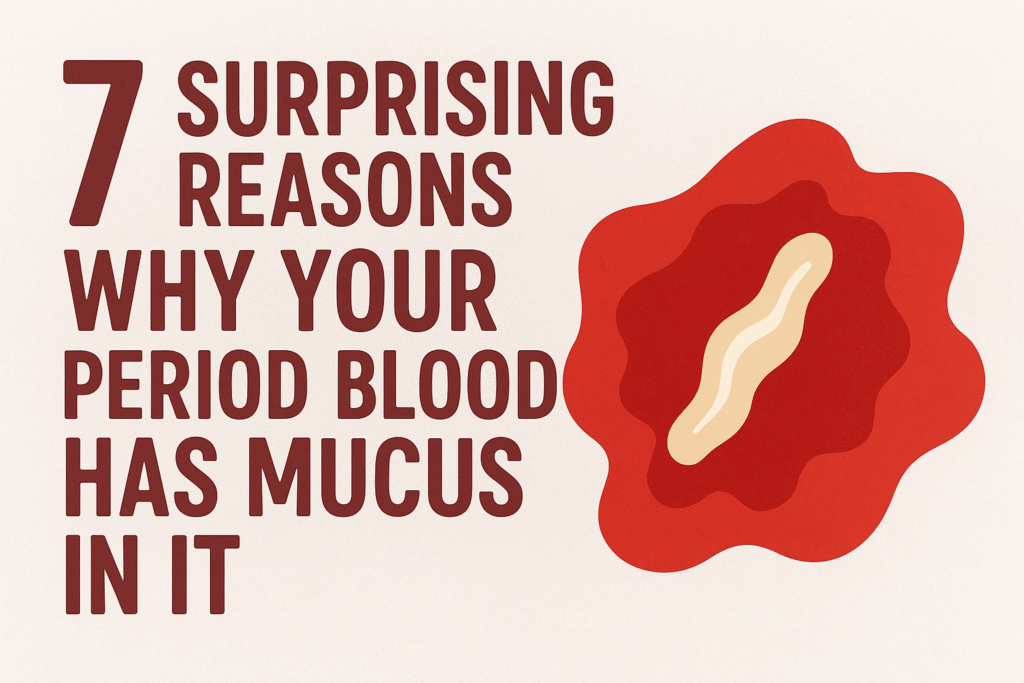
⚠️ Affiliate Disclaimer: This post may contain affiliate links, which means I may earn a small commission — at no extra cost to you — if you make a purchase through one of these links. I only recommend products or services I genuinely trust and believe can provide value. Thank you for supporting My Medical Muse!
7 Surprising Reasons Why You Have Mucus in Period Blood and Why It’s Usually a Good Sign
It can be a little alarming to notice mucus or jelly-like clumps in your period blood but before you panic here’s the truth, having some mucus mixed in with menstrual blood is usually completely normal.
Your menstrual flow isn’t made up of blood alone, it’s a combination of blood, uterine tissue, cervical mucus, and vaginal fluids. So, seeing a bit of clear or white stringy mucus in your period blood is often just part of your body’s natural cycle.
Still, there are times when changes in the amount, color, or texture of that mucus can signal something else from hormonal imbalance to infection or reproductive system issues.
Let’s break it all down clearly.
What It Means When You See Mucus in Your Period Blood
Noticing mucus mixed with your menstrual blood can feel strange especially if it looks stringy, jelly-like, or slippery, but the presence of mucus is actually a normal part of your menstrual process and not necessarily a cause for concern.
Menstrual mucus typically appears as:
- Clear or whitish: This is your normal cervical mucus, which keeps the vaginal canal moist and healthy.
- Brown or dark red: Often a mix of old blood and mucus being cleared out from your uterus at the start or end of your period.
- Thick and clumpy: May suggest hormonal changes that affect the consistency of both blood and mucus.
- Sticky or stretchy: A sign that fertile cervical mucus is overlapping slightly with your menstrual flow common if you have a shorter cycle.
This mucus comes primarily from your cervix, the small passage connecting your uterus to your vagina. The cervix naturally produces mucus throughout your menstrual cycle to:
- Help sperm travel during your fertile window
- Protect the uterus from bacteria and infections
- Regulate the flow of menstrual blood and discharge
- Indicate where you are in your fertility cycle
So when your period starts, some of this mucus inevitably mixes with menstrual blood as it leaves the uterus. The result? A slightly slimy, jelly-like, or stringy texture in your flow, which is completely normal.
In short, mucus in your period blood is rarely something to worry about. It’s simply part of your body’s natural process of cleansing and renewing the uterine lining each month. Unless it comes with pain, odor, or unusual color, it’s just your body doing exactly what it’s meant to do.
Understanding How Cervical Mucus Changes Throughout Your Cycle
To truly understand why you might see mucus during your period, it helps to know how cervical mucus behaves at different stages of your menstrual cycle. Your cervical mucus is a mirror of your hormonal health, shifting texture, color, and amount as estrogen and progesterone rise and fall.
Here’s a simple breakdown of what happens each phase:
Cycle Phase | Dominant Hormones | Cervical Mucus Appearance | What It Means |
Menstrual Phase (Day 1-5) | Low estrogen, rising FSH | Mixed with blood, minimal mucus | Uterine lining sheds, releasing old blood and mucus |
Follicular Phase (Day 6-13) | Rising estrogen | Clear, stretchy (“egg white”) | Fertile mucus that helps sperm survive and travel |
Ovulation (Around Day 14) | Estrogen peaks, LH surge | Abundant, slippery, transparent | Indicates ovulation and peak fertility |
Luteal Phase (Day 15-28) | Progesterone dominates | Thick, sticky, creamy | Less fertile phase; mucus acts as a barrier |
Pre-period (Days before bleeding) | Estrogen and progesterone drop | Mucus thins and may mix with traces of blood | Prepares for menstruation to begin |
When your period begins, the last of that thick mucus from the luteal phase combines with newly released blood. This mix can give your flow a jelly-like or stringy consistency, especially during the first day or two.
Think of cervical mucus as a hormonal barometer. It reflects your cycle’s rhythm, so a little mucus during your period is simply your body transitioning smoothly from one phase to the next.
Normal Causes of Mucus in Period Blood
While mucus can sometimes seem unusual, it’s usually just your hormones doing their job. Let’s explore the most common, harmless reasons why mucus shows up in your menstrual flow:
1. Cervical Mucus Carryover
At the beginning or end of your period, your cervix may still be producing fertile-type mucus, especially if your hormone levels are shifting between phases.
When menstrual bleeding starts, this clear or white mucus blends with fresh blood, creating a slippery, stringy, or slightly gelatinous discharge.
You might notice this more clearly on lighter flow days, when blood volume is low and mucus is easier to spot. It’s a sign that your hormones are in normal transition, not that something’s wrong.
2. Hormonal Fluctuations
Your hormone balance mainly estrogen and progesterone controls both:
- How thick or thin your cervical mucus is
- How quickly your uterine lining breaks down and sheds
Even slight imbalances, triggered by stress, sleep changes, diet, or birth control, can alter mucus consistency.
For example:
- Higher estrogen may make mucus thinner and more noticeable during your period.
- Higher progesterone can make it thicker and creamier.
This is one reason your period may sometimes appear more “jelly-like” or mucousy from one month to another, your body is responding to its unique hormonal pattern that cycle.
3. Early or Light Period
If your period begins gradually with spotting or light bleeding, your mucus will be more visible before the full flow begins.
This can happen when:
- You’ve had a stressful month (which delays or lightens ovulation)
- You’re recovering from illness
- You’ve recently changed or stopped birth control
- You’ve experienced weight changes or sleep disruption
Because less blood is being released, the proportion of mucus to blood is higher, making it look more prominent.
This is completely normal and often resolves once your hormonal rhythm stabilizes.
4. End of Period “Clean-Out”
Toward the end of your cycle, your uterus performs a final “clean-out” releasing the remaining bits of tissue, mucus, and old blood.
This mix often appears:
- Brownish or dark red
- Sticky or jelly-like
- Thicker than your normal flow
It’s simply your uterus expelling the last bits of the lining before resetting for a new cycle.
This kind of mucus is a healthy sign that your uterus is finishing its shedding process completely.
5. Ovulation Overlap
If you have a shorter cycle (less than 26 days), it’s possible for ovulation to occur soon after your period ends.
During this time, your cervix begins producing fertile, clear, stretchy mucus again, even if traces of menstrual blood are still present.
The result? A pinkish or jelly-like mix of blood and clear mucus that looks unusual but is actually a normal ovulatory overlap.
This overlap can be particularly noticeable if you have:
- Irregular cycles
- Short luteal phases
- Naturally early ovulation
It’s not harmful, but it can make tracking your fertility slightly more confusing, which is why cycle tracking apps or basal body temperature monitoring can help you understand these subtle overlaps better.
6. How Flow Intensity Affects Mucus Appearance
You may also notice that the heavier your flow, the less visible mucus seems. That’s because the higher volume of blood dilutes it.
Conversely, during lighter flow days, mucus becomes more obvious sometimes giving the impression of an unusual texture or discharge.
So if mucus appears thicker or more noticeable during the first or last days of your period, that’s typically a simple change in ratio, not a sign of infection or illness.
Key Takeaway
Mucus in your menstrual blood is a reflection of your hormonal balance, cervical health, and cycle timing. In most cases, it’s your body functioning perfectly clearing out the old and preparing for the next cycle.
It only becomes a concern if:
- The mucus changes color (gray, green, or yellow)
- There’s a strong, unpleasant odor
- It’s accompanied by pelvic pain, itching, or fever
Otherwise, that jelly-like texture is simply your reproductive system doing its monthly reset.
When Mucus in Period Blood Might Indicate an Issue
While mucus itself isn’t usually a problem, certain changes in color, smell, or consistency can hint at something deeper.
Here’s what to watch for:
a. Unusual Color
- Gray or green mucus: May signal bacterial vaginosis (BV) or another infection.
- Yellow mucus with blood: Could indicate cervicitis or sexually transmitted infections (STIs) like chlamydia.
- Very dark, tar-like mucus: May mean old retained blood, sometimes seen with hormonal imbalance or fibroids.
b. Foul Odor
A strong, fishy, or rotten smell isn’t normal, it can point to infection, vaginal dysbiosis, or trapped tissue (in rare cases, like a forgotten tampon).
c. Large or Frequent Clots
Small jelly-like clots are common, but large, frequent clots (larger than a quarter coin) might suggest heavy bleeding, fibroids or endometriosis.
d. Pelvic Pain or Cramping
Severe pain along with mucus-heavy flow may signal:
- Endometriosis
- Adenomyosis
- Uterine fibroids
- Pelvic Inflammatory Disease (PID)
e. Irregular or Spotting Between Periods
If mucus mixed with blood shows up between cycles, not during your period, it may be linked to ovulation spotting, implantation bleeding, or cervical irritation.
The Hormonal Connection: Estrogen, Progesterone, and Mucus
Hormones are the master controllers of your menstrual cycle and mucus is one of their most visible messengers.
Estrogen
- Boosts cervical mucus production.
- Makes mucus clear, stretchy, and slippery (like egg whites).
- Peaks around ovulation but also plays a role in early menstruation.
Progesterone
- Thickens and dries cervical mucus after ovulation.
- Dominates in the second half of your cycle.
- When it drops right before your period, the cervix releases leftover mucus as the uterine lining sheds.
If you experience consistent mucus-heavy periods, you might have mild hormonal imbalance such as estrogen dominance or low progesterone.
Common signs include:
- PMS mood swings
- Breast tenderness
- Irregular or heavy cycles
- Bloating and fatigue
Other Medical Causes to Consider
While most cases are benign, these are medical conditions where mucus-like menstrual flow may appear:
a. Endometriosis
Endometrial tissue growing outside the uterus can lead to thick, stringy mucus, dark blood, and painful periods. The mucus may be mixed with old blood and appear almost gel-like.
b. Adenomyosis
This occurs when the uterine lining grows into the uterine wall. It causes heavy bleeding, thick discharge, and severe cramps.
c. Cervical or Uterine Polyps
Polyps (small growths) can secrete mucus and cause bloody mucus discharge between or during periods.
d. Infections (BV, Yeast, STIs)
Infections can change your mucus texture and color causing yellow, gray, or greenish mucus with blood streaks.
e. Perimenopause
Fluctuating estrogen during perimenopause can alter both mucus production and flow patterns, sometimes creating thicker, jelly-like discharge in your late 30s or 40s.
Lifestyle and External Factors That Can Affect Menstrual Mucus
Diet and Hydration
Low water intake or dehydration thickens cervical mucus.
Eating more omega-3s, fruits, and leafy greens supports healthy mucus production.
Medications and Birth Control
Hormonal contraception, fertility drugs, or IUDs can change how your cervix produces mucus, sometimes making it more noticeable during periods.
Stress
Chronic stress disrupts hormone balance, which may lead to unusual mucus or irregular bleeding.
Sexual Activity
Intercourse near your period can mix semen and vaginal secretions with menstrual blood, temporarily changing its color and consistency.
How to Tell What’s Normal vs. Not
You can often identify whether your mucus is normal by paying attention to:
- Timing: If it happens only during your period, it’s likely normal.
- Color: Clear, white, pink, or red is fine. Yellow, green or gray is not.
- Odor: A mild metallic scent is typical. Strong odors are not.
- Symptoms: Pain, itching, or fever always warrant medical attention.
Try tracking your period for a few cycles, note mucus changes, flow patterns, and pain levels. This helps you spot patterns or abnormalities early.
When to See a Doctor
Schedule a gynecologist visit if you notice:
- Persistent mucus-heavy bleeding every month
- Unusual color or odor
- Painful cramps unrelieved by OTC medication
- Periods longer than 7 days
- Large clots or excessive flow
- Mucus between periods or after sex
Your doctor may perform:
- Pelvic exam
- Pap smear
- Ultrasound
- Hormone tests
These tests help rule out infections, fibroids, or hormone-related issues.
How to Manage and Support Healthy Menstrual Flow
Even when mucus in your period is normal, you can support your reproductive health with simple habits:
a. Stay Hydrated
Drink at least 2-3 liters of water daily. Hydration keeps cervical mucus thin and healthy.
b. Balance Hormones Naturally
Include:
- Healthy fats (avocado, nuts, olive oil)
- Iron-rich foods (leafy greens, lentils, red meat)
- Magnesium and B6 (bananas, whole grains)
These nutrients stabilize hormone production and menstrual cycles.
c. Reduce Stress
Chronic stress raises cortisol, which disrupts estrogen and progesterone. Try yoga, breathing exercises, or short walks.
d. Avoid Harsh Vaginal Products
Douching, perfumed wipes, or soaps can irritate your vaginal flora and alter mucus balance.
e. Track Your Cycle
Use an app or journal to note changes in mucus, flow, and pain levels. Patterns reveal a lot about hormonal shifts and reproductive health.
Common Myths About Mucus in Period Blood
Let’s clear up a few misunderstandings:
Myth 1: Mucus means infection.
Not necessarily. Clear or white mucus during menstruation is normal. Infection-related mucus usually smells bad or looks green/yellow.
Myth 2: Mucus indicates pregnancy.
While early pregnancy can produce thick mucus discharge, during your actual period, this isn’t a pregnancy sign.
Myth 3: Mucus means your body isn’t cleaning properly.
Actually, it’s the opposite, mucus helps your body cleanse the uterus efficiently by easing blood passage.
Myth 4: You should remove mucus-like clots manually.
Never try that. Your uterus expels what it needs naturally. If clots are too large or painful, consult your doctor instead.
What Healthy Menstrual Mucus Looks Like
A healthy, normal menstrual flow might include:
- A few jelly-like streaks in your blood
- Smooth, slightly slippery texture at the start or end
- No strong odor
- Gradual color change from bright red to dark red to brown.
Anything outside this range like gray, green, or foamy mucus deserves medical attention.
Summary: When to Relax vs. When to Get Checked
Situation | What It Likely Means | Action |
Clear or white mucus mixed with blood | Normal cervical mucus | No action needed |
Thick, jelly-like mucus early or late in period | Hormonal or cycle variation | Track and monitor |
Foul-smelling, yellow or green mucus | Infection or STI | See a doctor |
Painful periods with thick mucus | Possible endometriosis or fibroids | Medical evaluation |
Mucus between periods or after sex | Cervical irritation or polyp | Get checked |
Final Thoughts
Seeing mucus in your period blood might look odd, but it’s rarely something to worry about. Your body is a finely tuned system and cervical mucus plays a vital role in keeping your reproductive tract healthy, lubricated, and infection-free.
However, always listen to your body, if the mucus changes in color, smell, or consistency or if it comes with pain or irregular bleeding, don’t ignore it. A simple checkup can rule out infections or hormonal imbalances early. Your menstrual cycle is a window into your overall health, understanding every part of it even the jelly-like bits helps you connect more deeply with your body and notice what it’s trying to tell you.
👩⚕️ Need Personalized Health Advice?
Get expert guidance tailored to your unique health concerns through MuseCare Consult. Our licensed doctors are here to help you understand your symptoms, medications, and lab results—confidentially and affordably.
👉 Book a MuseCare Consult NowRelated Blog Post You Might Like:
- 7 Surprising Reasons Why Your Discharge Increased Suddenly Mid-Cycle And Why It’s Usually a Good Sign
- 8 Surprising Reasons Why Your Period Blood Looks Watery and Why It’s Usually Nothing to Worry About
- 7 Interesting Reasons Why Your Body Feels Heavy Before Your Period and Why It’s Totally Normal
- 10 Surprising Reasons Why Your Period Suddenly Became Shorter This Month and Why It’s Not Always Bad
- 10 Powerful Reasons Why You Get Dizzy Right Before Your Period
- Breast Pain Before Period: 7 Powerful Causes, Symptoms, and Relief Tips
- Can You Get Pregnant on Your Period? 7 Key Facts Every Woman Should Know


